Gigabyte GM-M8000 Mouse - A GHOST Story
by Gary Key on June 15, 2009 3:00 PM EST- Posted in
- Smartphones
- Mobile
Gigabyte ships version 1.00 of their GM-M8000 AP software suite in the current retail package. Based upon our early testing with it in Vista 64, we just recommend using the CD as wall art and download version 1.02 before you use the mouse. Gigabyte also ships a nifty 4D Wheel Driver utility that allows you to setup the scroll wheel via a new tab in the standard Windows mouse control application. Gigabyte's software installation is simple and easy while requiring about 11.5MBs of disk space. The software supports Windows XP, XP-64 Edition, Vista, and Windows 7. The mouse worked in Mac OS X and various Linux builds but the software that enables special features and button assignments is not compatible with either operating system, thus negating the major benefits of the GM-8000.
The primary purpose of the GM-8000 AP software suite is to allow complete control over the mouse's hardware capability. The interface is simple and intuitive. The program offers a vast array of options to control the various buttons and center wheel on the mouse. We could spend pages on showing each of the 30 individual settings available to each button and a vast array of Macro settings. Instead, we will simply display the configuration windows and recap any major items of interest we discovered during testing. One item we suggest the user have available is a decent pair of sunglasses when using the software as the bright yellow background could cause blindness in small children and pets. However, you do get used to it over time but we wish that Gigabyte would utilize their corporate blue color scheme in future software releases.
Once we loaded the software and rebooted, the first order of business was to understand how memory hungry the two applications are in Windows Vista 64 Ultimate. The results were surprising considering our experiences with the Logitech programs. GM_M8000.exe and Wh-exec.exe consumed a total of 6.5MB of memory while active compared to the 18MB footprint of the Logitech SetPoint software. CPU usage was nominal during all phases of testing.
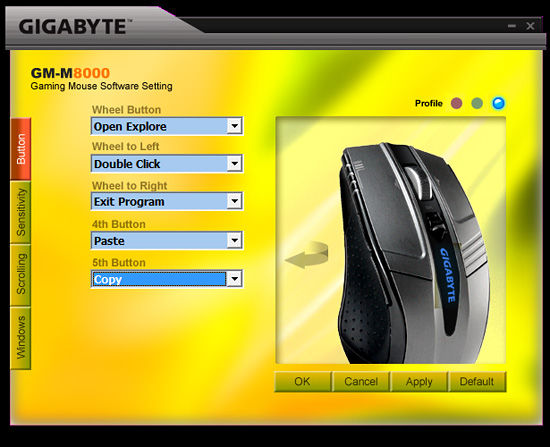
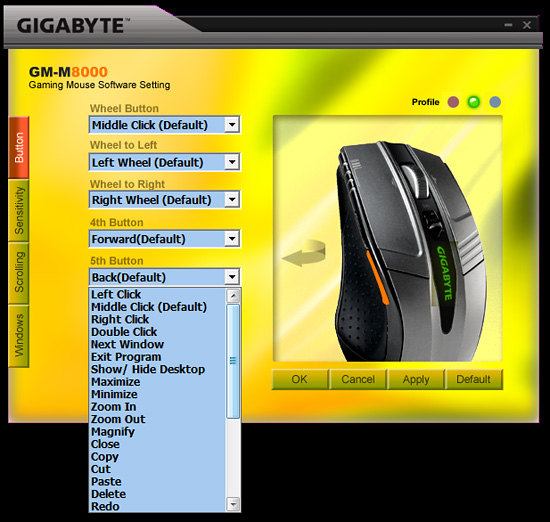
The primary screen allows the user to define the function of the scroll and thumb buttons. A listing of the additional button command options is shown in the pull down screen. Each of the left side buttons or the scroll wheel has its own display screen and option choices.
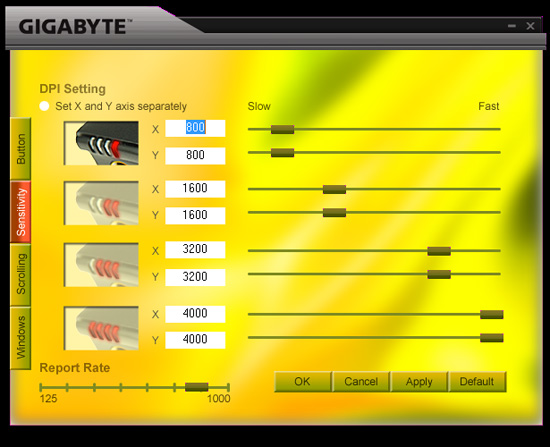
The Sensitivity section will change your perspective on life in general and allow you to become a better person. Actually, it provides quick adjustments to the dpi settings on an individual basis for the X and Y-axis if required. The dpi button on the mouse will utilize the user requested changes in this tab. The user can also adjust the USB report rate from this screen.
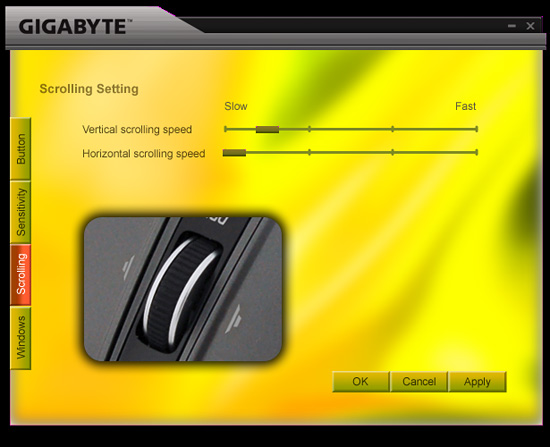
The Scrolling section allows for individual settings for both the vertical and horizontal scrolling speeds. The settings are very basic and we noticed once you got past the first tab marker on the slow side that the scroll speeds tended to get out of control.

The Windows tab will bring up Window’s mouse properties box that now includes a new tab to adjust the scroll speeds with finite control and to test those changes before accepting them. This section also includes the ability to set the mouse in MS-Intelli Mouse compatible mode in case your application is having problems with the GHOST software mode. The left and right scroll button commands did not always work in several applications without having the driver set installed. Even when installed, the left/right feature did not work in freeware applications like Sweet Home 3D (wonderful home planning tool) or several flash based games. However, this feature did work in the major application packages we tested.
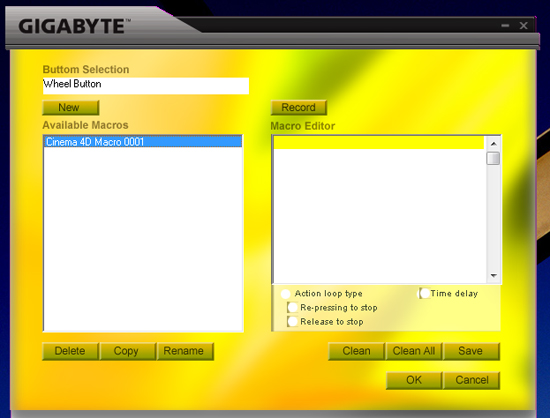
One of the most unique features on this mouse is Macro capabilities for the adjustable buttons. The two side buttons (4th/5th) have 509 bytes of memory assigned to them that equates to about 200 script commands. The scroll wheel button has 253 bytes of assigned memory that equates to around 96 script commands. The user can design up to 15 custom Macros over the three profiles. We were able to setup a variety of Macros ranging from simple open and close commands to actually running several of our mouse friendly benchmarks in programs like CyberLine Power Director 7 or Maxon Cinema 4D R11.
Multimedia programs like Windows Media Center or iTunes did not work properly with the Macro commands. Gigabyte actually warns the user that several media applications might not work right in their written documentation, so no points off those problems. The most useful function was the interval time function that could be set to wait a predetermined time between two commands that allowed several of our mouse friendly benchmarks to complete with a single click of a button. Alright, a true scripting language is better suited for that purpose but it does show the power of the Macro capability on this mouse.
















44 Comments
View All Comments
kzage - Tuesday, June 16, 2009 - link
Good review, I enjoyed it.Socaddict - Tuesday, June 16, 2009 - link
Considering that the G5 is at least three years old, with a two year old revision. I know that they are at similar price points, but in terms of feature set and the like, isn't the G9 a more appllicable comparison, at least in terms of age and expectations.Over here in the UK, theres little difference in pricing between the gigabyte, G5 and G9,
On the subject of being able to install software, then uninstall, the G9 also offers that feature, as you can save profiles, macros, etc to the mouse, and carry only that with you. I've carried my G9 settings across two XP installs, and now on a Windows 7 RC1 install, and its working perfectly, with all the macros I had saved.
XtAzY - Tuesday, June 16, 2009 - link
Can you guys review the Roccat Kone mouse? It looks pretty cool compare to this one and has many good reviews in the European countries.XtAzY - Tuesday, June 16, 2009 - link
Oops forgot the link to the site:http://www.roccat.org">http://www.roccat.org
nubie - Tuesday, June 16, 2009 - link
Interesting. But . . .For $50 you can get a dual-core 45nm 2MB level 2 cache Intel processor. This mouse would need to feed me unlimited cheetos, pizza and root beer to make up the value-for-money.
I have a problem with mouse drivers. I think they are useless. Then again I think any "driver" that needs a widget running after you have set whatever settings it needs (and then never touch the thing again, ever) is a stupid proposition.
Why can't the functionality be embedded in a simple driver that operates within the OS (or in hardware on the Mouse itself). Run the program, set the mouse, delete the program.
Move it to a MAC or Linux or Playstation 3 and it will still keep the settings, no "drivers" necessary.
I am very function over form, it should just work without the crappy blech. I mostly make do with $3 Logitech optical mice, but I don't game or anything else (CG/Photo manip./CAD) 99% of the time. You plug it in, it moves the cursor, scrolls the webpage, selects or brings up a context menu, rinse repeat.
jordanclock - Tuesday, June 16, 2009 - link
The people that spend $50 on a mouse don't spend $50 on a processor (unless they spend four times as much on cooling to overclock it to extreme levels), so I don't think that is necessarily an accurate comparison. I agree with your point about these "mouse apps" that are necessary to get full use of all the features. I am almost positive I read a review of a mouse that does exactly what you describe: The widget program is only run to change the settings of the mouse, then they're saved to the mouse. I can't remember what mouse it was for the life of me, but I do remember wanting to buy it for that reason.overzealot - Monday, June 15, 2009 - link
"Gigabyte also allows dpi on-the-fly adjustments of 800, 1600, 3200, and 4000 compared to 400, 800, and 2000 on the G5."I think this is a bit out of place, considering you can have 1 to 5 sensitivity settings in the range from 400 - 2000 on the G5 (not indicated in article), and similarly programmable settings on the GHOST (as indicated later in the article).
jordanclock - Tuesday, June 16, 2009 - link
But the GHOST has two settings that are higher than the G5 has available. It is completely relevant. Is it particularly useful? That hasn't been objectively determined because we don't know at what DPI value that other limitations become bigger factors.Ecmaster76 - Monday, June 15, 2009 - link
Since everything is slow, it might be a good time to review sound cards, periphreals, etc. Those things are important too.BTW The GHOST logo reminds me of Spawn *a lot*.
JohnMD1022 - Monday, June 15, 2009 - link
1. Do you think it will show up in Best Buy?2. Ive had a couple of wireless mice. They were OK until they failed, or lost synch, whichever came first.
3. What's wrong with wired? My wife hated the CAT 5 cable across the floor, and had to have wireless. Her wired connection never went down.
4. I'm not a gamer, so all the extra buttons are a PITA. I use a Logitech LX3 (and an IBM Model M keyboard). I've used Logitech mice for over 20 years. Give me a fast laser mouse with no extras and maybe I'll buy one.